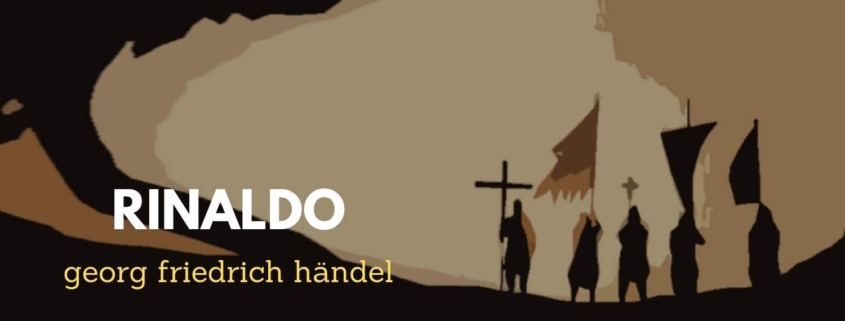Cara sposa – an aria from the opera Rinaldo
The opera guide of George Frederic Händel’s aria CARA SPOSA
Read Interesting facts and hear great YouTube Videos about Händel’s famous Aria “CARA SPOSA“.
If you want to read and hear more about RINALDO, click on this link to the opera portrait
The aria CARA SPOSA – synopsis and background
Synopsis: Jerusalem is besieged by the crusaders. In the Christian camp are their leader Goffredo, his daughter Almirena and his commander Rinaldo. Goffredo promises Rinaldo the hand of his daughter Almirena as a reward when they defeat the sarazenes. She joyfully awaits her marriage with the commander and urges him to fight. Argante, the ruler of Jerusalem demands 3 days of truce, which Goffredo, sure of victory, generously grants him. Argante wants to gain time to make a plan with his wife, the sorceress Armida, to change the fortunes of war in their favour. Armida sees their only chance if they succeed in eliminating Rinaldo. Without his martial arts the Christians would not be able to take Jerusalem. So Armida kidnaps Almirena before Rinaldo’s eyes with the help of magic. She appears from a black cloud with monsters at her side, against which Rinaldo is powerless. Lonely, Rinaldo laments the loss of his beloved.
Handel said of this aria that it was perhaps the most beautiful he had ever written. It is one of his great arias for castratos, which he wrote for these singing virtuosos with their long breath. The first interpreter of this aria was Nicolini, the most famous castrato of his time (Farinelli was only 10 years old at the time of the premiere).
It became famous through the opera Rinaldo, it originally stems from his oratorio “la resurrezione”.
The aria, titled Largo, begins with a short introduction by the violins. Three groups play a beautiful 3 voice motive without bass. The combination of the E minor with the chromatic steps evokes the feeling of abandonment and despair of Rinaldo.
The piece begins with a big Messa di voce, which consists “of a rise and fall (crescendo, decrescendo) of the voice volume during the sustaining tone, ideally from pianissimo to fortissimo and vice versa, without changing the pitch and other aspects such as intonation and vibrato. The castratos of the Baroque period, which were generally very powerfully built, were thus able to demonstrate their controlled power and lung volume” (Wikipedia). The following notes must be sung with the greatest legato and chromatic changes of tone to create the desolation of the moment:
The basso continuo is not added until measure 24. The string counterpoint becomes richer and the vocal part could also be another violin part in the vocal network.
Handel’s lamentations are one of his greatest specialities. An important stylistic element of these laments were the sigh motives. Chromatic tone sequences, dying tones and resigning pauses create the resigned mood:
Afterwards, the fast part according to the scheme A-B-A’ (slow-fast-slow):
Written for a “Castrato”
The role of Rinaldo has been written for a Castrato. Castratos are singers who have been castrated before puberty in order to prevent voice changes and to preserve a beautiful soprano or alto voice even in adulthood. In their training, the castratos learned the perfect mastery and control of their breath, which was the foundation of their singing skills. In addition, they were given singing exercises that specifically trained the softness, strength, fluency and colouratura of their voice, and especially the trill. (from: Wikipedia)
Since castratos do not exist anymore, the roles are often sung by countertenors.
A countertenor is a type of classical male singing voice whose vocal range is equivalent to that of the female contralto or mezzo-soprano voice types. Countertenors often are baritones or tenors at core, but on rare occasions use their lower vocal range, instead preferring their falsetto or high head voice. (Source: Wikipedia)
The Aria – the text of CARA SPOSA
Cara sposa, amante cara,
Dove sei?
Deh! Ritorna a’ pianti miei!Del vostro Erebo sull’ara,
Colla face dello sdegno
Io vi sfido, o spirti rei!Verse-moi, verse-moi l’ivresse!
Beloved spouse, dearest heart
Where art thou?
Woe! Return to him who weeps!O guilty spirits from thy Erebus altar
My face on of complete contempt,
I defy thee, wicked spirits!
Beloved spouse, dearest heart
Where art thou?
Woe! Return to him who weeps!O guilty spirits from thy Erebus altar
My face on of complete contempt,
I defy thee, wicked spirits!
Famous interpretations of CARA SPOSA
We first hear the aria in the interpretation of David Daniels, the famous American countertenor. He sang the Rinaldo in Hogwood’s sensational recording with Cecilia Bartoli in the leading role. His voice is touching with naturalness and opulence.
Cara sposa – Daniels
Another star of the countertenor scene is Andreas Scholl. His voice is a bit more masculine than that of Daniels. The interpretation seems a bit more soulful, which is possibly caused by the much slower tempo.
Cara sposa – Scholl
Iestyn Davies has a softer, more feminine voice.
Cara sposa – Davies
With a soft voice and beautiful mezza di voce Daniel Taylor breathes the Cara sposa into the microphone.
Cara sposa – Taylor
Jaroussky also has a clear and tender voice, his messa di voce and legato beautifully and the interpretation is more moving, more agitated than the latter.
Cara sposa – Jaroussky
Here is an excerpt from the film “Farinelli” with this aria.
Cara sposa – Movie Farinelli
Peter Lutz, opera-inside, the online opera guide to the song “CARA SPOSA” from the opera “Rinaldo” from George Frederic Handel.








Leave a Reply
Want to join the discussion?Feel free to contribute!